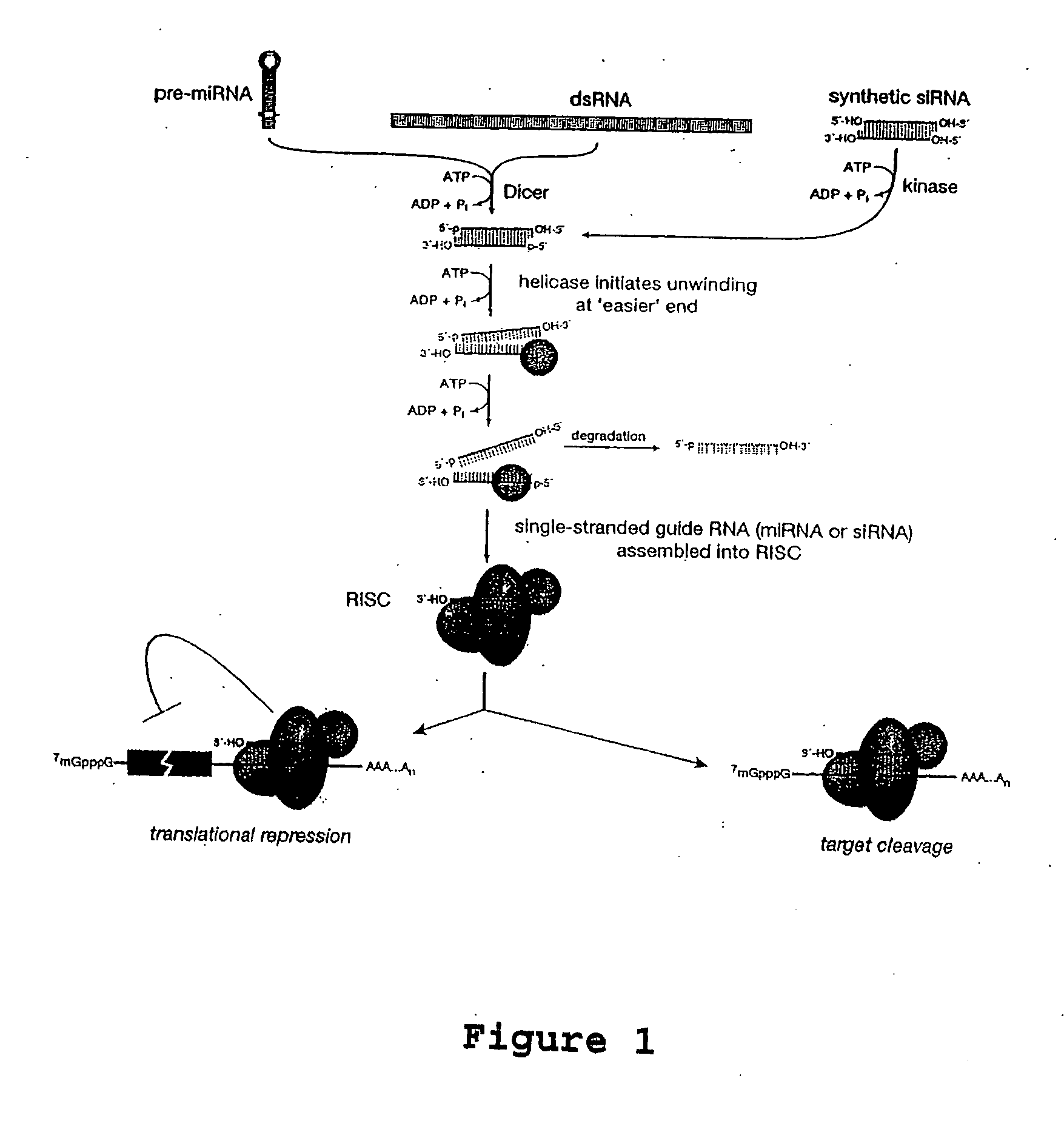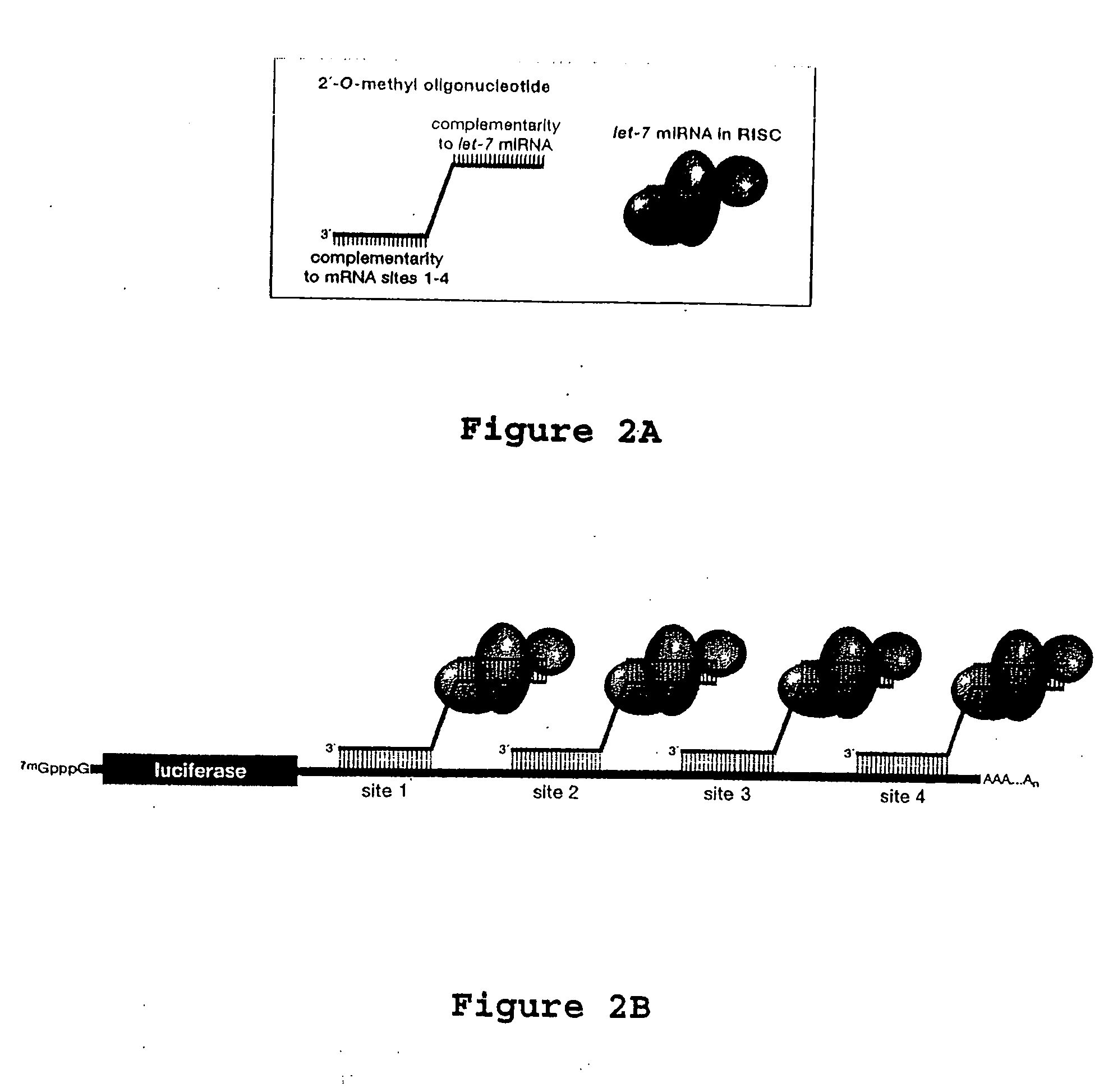Dual functional oligonucleotides for use in repressing mutant gene expression
a functional oligonucleotide and mutant technology, applied in the direction of genetic material ingredients, organic chemistry, drug compositions, etc., can solve the problem of elusive use of mrna for biological processes in mammals, and achieve the effect of increasing the in vivo stability of the agen
- Summary
- Abstract
- Description
- Claims
- Application Information
AI Technical Summary
Benefits of technology
Problems solved by technology
Method used
Image
Examples
example 1
Probing miRNA as an Effector in RNA Silencing
[0129] miRNA binds to miRNA sites through nucleotide complementarity. Like siRNA, miRNA forms complexes with RISC proteins. The mechanism by which miRNA blocks translation is unknown. Mammalian cells have ˜250 distinct miRNAs (Lagos-Quintana et al. (2002); Logos-Quintana et al. (2001); Lim et al. (2003)). In the instant example, a miRNA in abundance is recruited to the htt miRNA using a 2′-O-methyl oligonucleotide complementary to both the miRNA and the miRNA target. 2′-O-methyl oligonucleotides have been shown to be irreversible, stoichiometric inhibitors of both siRNA and miRNA function (Hutvagner et al. (2004) PLOS Biology, in press). The method recruits the miRNA-programmed RISC to the miRNA and block synthesis of mutant huntingtin protein.
[0130]FIG. 2 depicts interactions between the designed 2′-O-methyl oligonucleotide and an endogenous miRNA. FIG. 2 further depicts the general design of an embodiment of the 2′-O-methyl oligonucle...
example 2
miRNA Translation Repression of Mutant Huntingtin Protein
[0133] In the instant example, miRNA recruitment to effect translation repression of huntingtin is tested. Initial test paradigms, under controlled conditions, are established before testing for huntingtin miRNA. Since huntingtin miRNA is susceptible to siRNA-directed RNAi in HeLa cells, the first study uses 2′-O-methyl oligonucleotide against huntingtin miRNA in HeLa cells. Three tests are applied. First, 2′-O-methyl oligonucleotides directed against huntingtin miRNA sequences with let-7 miRNA-complementary extensions are constructed as shown in FIG. 2. Huntingtin miRNA sites (six in series) are inserted into a luciferase reporter (FIG. 2). Translational repression is measured by luciferase activity in a luminometer. Next, the oligonucleotide is transfected into HeLa cells and huntingtin protein is measured on Western blots. Huntingtin is quantified on LAS3000 (Fuji, Stamford, Conn.). Controls include transfection of miRNA a...
example 3
Exploring the Requirements for siRNA Translational Repression
[0136] In both plants and animals, siRNAs are perfectly complementary to their targets, directing cleavage of the RNA target at the middle of the binding site. In contrast, animal miRNAs usually act as sequence specific translational repressors. About one percent of animal genes encode miRNAs, many of which are evolutionally conserved, and they regulate diverse cellular functions, including developmental timing, cell proliferation, cell death, and fat metabolism. Both endogenous miRNAs and exogenous siRNA's can direct the destruction of an miRNA at any single binding site to which they are sufficiently complementary. In contrast, miRNAs and siRNAs that are insufficiently complementary to support cleavage of the RNA target can nonetheless direct translational repression if the target contains multiple, partially complementary RNA binding sites in the 3′ untranslated region. The following experiments utilized RNA modificati...
PUM
| Property | Measurement | Unit |
|---|---|---|
| time | aaaaa | aaaaa |
| time | aaaaa | aaaaa |
| time | aaaaa | aaaaa |
Abstract
Description
Claims
Application Information
 Login to View More
Login to View More - R&D
- Intellectual Property
- Life Sciences
- Materials
- Tech Scout
- Unparalleled Data Quality
- Higher Quality Content
- 60% Fewer Hallucinations
Browse by: Latest US Patents, China's latest patents, Technical Efficacy Thesaurus, Application Domain, Technology Topic, Popular Technical Reports.
© 2025 PatSnap. All rights reserved.Legal|Privacy policy|Modern Slavery Act Transparency Statement|Sitemap|About US| Contact US: help@patsnap.com



